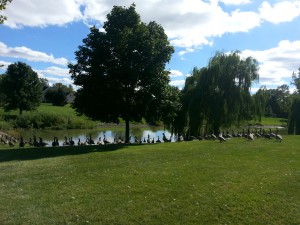This week’s reading is about color. Subjects in photos which are consisted of different color combinations will give off different feelings.
The photo above shows a analogous color scheme. Analogous colors are colors that are adjacent to one another on a color wheel. When analogous colors are put together, since they are combinations of colors that are less contrasting to each other (e.g. blue and green are less contrasty than red and blue), the colors tend to harmonize together.
This photo consists of yellow-green (grass), blue-green (lake) and blue (sky). These three colors are adjacent colors on the color wheel. As a result of the harmonizing colors, the photo gives a very harmonious feel portraying the natural scenery. It gives a very calming sensation.
This photo shows a complementary color scheme. Complementary colors are opposite to one another on the color wheel. When placed next to each other, their saturation increases and makes a really large contrast between the colors.
This is taken at the 8/F of the library. The blue (sky) and the orange (sun) are the complete opposite on the color wheel, and when put together it enhances the colors’ saturation and maximizes the contrast between the two. The saturation is ideal for a sunset photo because it then can demonstrate the warmth and romance of the sunset, while keeping a contrast with the originally blue sky and not when the whole sky is orange which gives no special contrast to the photo. The color scheme suits the subject – sunset ideally with the saturation it portrays.


